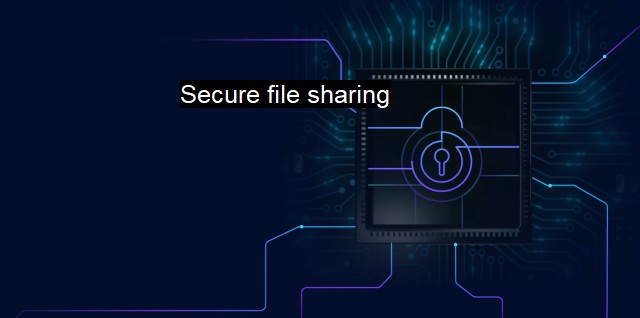What is Secure file sharing?
Protecting Your Data: Understanding the Importance of Secure File Sharing in the Cyber World"
Secure File Sharing is an integral aspect with providing safety mechanisms for transfers of data between users. This process involves protecting data files shared either over the internet or within a private network, ensuring these files are not affected by any outside or malicious influences.In the era of modern technology, exchanging large amounts of data has now become a common occurrence in most personal and professional dealings. While advances in technology have enabled the easy dissemination of data on the internet, it has simultaneously uncovered a multitude of threats - posing numerous risks to the confidentiality, integrity, and availability of these energy resources every step of the way.
This is where Secure File Sharing comes into play. As a proactive measure Secure File Sharing is designed to protect sensitive information, making sure it only reaches the intended recipient. It helps eliminate any unauthorized interference, data corruption, or potential exploits that might be attempted by cybercriminals.
‘File sharing' canonically denotes the practice of distributing or allowing access to digital files, like documents, multimedia, e-books, and programs. Despite its significant advantages in terms of data accessibility and collaborative working, unrestricted file sharing can potentially put all types of data at risk, constituting a compelling privacy concern. Therefore, Secure File Sharing is essentially a method to uphold privacy regulations and conserve intellectual property while still enabling resources' distribution and facilitating collaborative operations.
Secure File Sharing features an intricate web of encryption protocols. Encryption is a technique that transforms confidential data into an unreadable format, which cannot be understood logically unless decrypted using a decryption key. This unique aspect of encryption grants another layer of security, ensuring that any unintended recipients will not be able to access the data within the file.
Equally important is the addition of antivirus in Secure File Sharing. Antivirus software plays a crucial role in detecting any threats or malicious software that might come packaged in shared files. As files transfer between systems, they are scanned for potential threats to maintain the systems's integrity and efficiency, enhancing the overall security of file sharing.
Secure File Sharing fundamentally employs a myriad of protective measures to ensure the enhanced security of shared files. The constituents include but are not limited to firewall protections, restricted permissions, password-protected files, and Virtual Private Networks (VPN).
While files are being shared, these components aim to mitigate the risk of cyber threats within the information exchange process. Firewall protections act as a barrier between the internet and the internal network, screening internet traffic and, thus, preventing unauthorized access. By restricting permissions, Secure File Sharing permits only specific users to access certain files; hence, the risk of data breach dwindles significantly.
Data has been deemed as the 'new oil', making its protection extremely crucial in today's digital world. Through secure file sharing, personal or business data is maintained confidential amongst authorized entities, defending against the growing army of cybersecurity threats. It is not merely an addendum but an imperative to have Secure File Sharing protocols implemented within both personal and commercial domains.
To summarize, Secure File Sharing is an essential cog in the cybersecurity mechanism, ensuring that file sharing processes are shielded against malicious cyber threats, file corruption, unauthorized access and data circulation to unintended quarters. Perfectly blending functionality and protection, the process involves multiple safety measures, including but not limited to encryption, use of antiviruses, firewall protection and restricted permissions. By employing Secure File Sharing, data owners can share their resources across the digital ecosystem safely, without the constant stress of jeopardizing sensitive information and jeopardizing its safety.

Secure file sharing FAQs
What is secure file sharing and why is it important for cybersecurity?
Secure file sharing refers to the process of transferring files between two or more parties with measures in place to ensure the confidentiality, integrity, and availability of the data. It is important for cybersecurity as it helps prevent unauthorized access, data leakage, and malware infections.What are some important factors to consider when choosing a secure file sharing platform?
Some important factors to consider when choosing a secure file sharing platform are end-to-end encryption, access controls, secure file storage, multi-factor authentication, and virus scanning. It is also important to verify that the platform complies with relevant cybersecurity standards and regulations.What are some best practices for secure file sharing?
Some best practices for secure file sharing are to use strong passwords or passphrases, enable two-factor authentication, always encrypt files before sending, avoid sharing sensitive data through email, regularly update and patch software, and be aware of phishing and social engineering attacks.What are some potential risks of using unsecured file sharing methods?
Using unsecured file sharing methods can put your data at risk of being intercepted, modified, or deleted by unauthorized parties. It can also lead to malware infections and compromise your device or network. Additionally, sharing sensitive data through unsecured channels can result in data breaches, legal liability, and reputational damage.| | A | | | B | | | C | | | D | | | E | | | F | | | G | | | H | | | I | | | J | | | K | | | L | | | M | |
| | N | | | O | | | P | | | Q | | | R | | | S | | | T | | | U | | | V | | | W | | | X | | | Y | | | Z | |
| | 1 | | | 2 | | | 3 | | | 4 | | | 7 | | | 8 | | |||||||